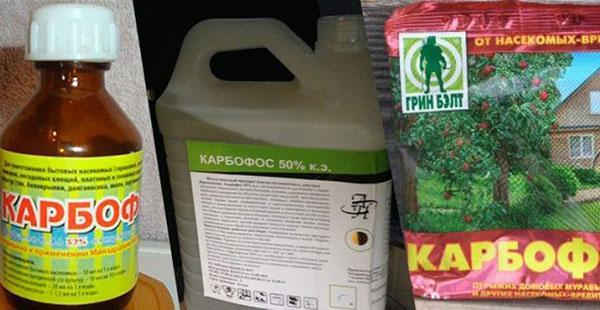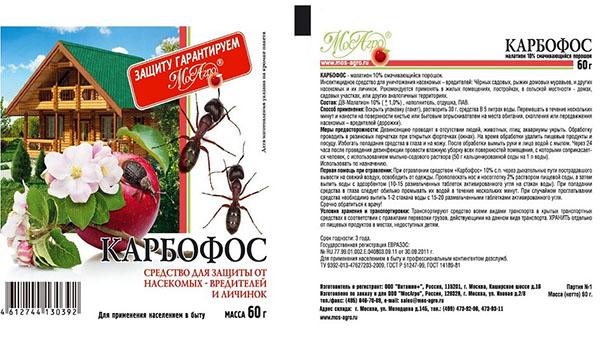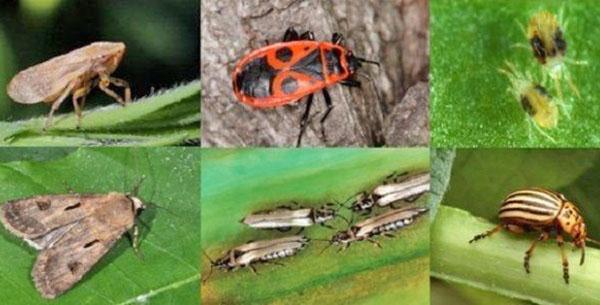The use of Karbofos in the garden and the garden - rules and regulations for processing pests
 The use of Karbofos for fruit and decorative crops will get rid of the main pests. It is a well-known organophosphorus compound with a high degree of toxicity. Due to its low cost and simple instructions for use, the drug continues to be used in the garden and vegetable garden instead of safer, but expensive analogues. It is sold in a concentrated form, so it is important to know the rules for preparing a working solution and using Karbofos in the garden and vegetable garden.
The use of Karbofos for fruit and decorative crops will get rid of the main pests. It is a well-known organophosphorus compound with a high degree of toxicity. Due to its low cost and simple instructions for use, the drug continues to be used in the garden and vegetable garden instead of safer, but expensive analogues. It is sold in a concentrated form, so it is important to know the rules for preparing a working solution and using Karbofos in the garden and vegetable garden.
Composition and release forms

The range of application of Karbofos extends to the beds and greenhouses, as well as premises. It is effective against most types of beetles and insectsthat destroy cultivated plants.
The drug is available in several forms:
- powder with a yellowish tinge, 30 and 60 g each - the most stable, but the most concentrated and toxic form, used after dilution with water;
- concentrated solution (50%) - also diluted with water before applying to plants;
- compact ampoules with ready-made working solution (10 and 50 ml);
- granules for tillage with Karbofos.
For the garden and vegetable garden, the drug is often used in the form of a powder. Ampoules with a ready-made solution have a short shelf life (up to 3 months) and are more popular for combating synanthropic pests, including cockroaches.
Mechanism of action and indications for use
 The instructions for the use of Karbofos indicate which pests the drug is effective against. This group includes scale insects, aphids, bugs and weevils, honeydew, thrips and gall midges, moths, mealybug and bean moth, cicada and other representatives. The substance is used to treat the garden after infection, since it acts not on plants, but on the body of beetles and insects.
The instructions for the use of Karbofos indicate which pests the drug is effective against. This group includes scale insects, aphids, bugs and weevils, honeydew, thrips and gall midges, moths, mealybug and bean moth, cicada and other representatives. The substance is used to treat the garden after infection, since it acts not on plants, but on the body of beetles and insects.
Before using Karbofos in gardening, you should pay attention to several of its features:
- Karbofos is a contact drug. It is only effective when it comes into direct contact with pests. Those representatives who have managed to avoid contact with the chemical continue to develop and harm the plants.
- The advantage of the drug is its fast action. Pests die almost immediately after treatment, but the insecticide does not prevent new insects from infesting.
- Karbofos is considered a short-acting remedy. Under the influence of water and air, it is destroyed in 7-10 days in the open field and in a week in greenhouses. Including the chemical is removed from plant tissues.
- The drug is intended for treatments in the event of pests, but not for prevention. In addition, its regular use can be addictive in some types of pests.
The drug has a detrimental effect on all types of insects. This feature can be attributed to the advantages, since one solution can get rid of any pest. However, the toxicity extends to beneficial insects, including bees.It is also known to be more effective against juveniles and larvae than against adults. Before processing greenhouses with Karbofos and beds it is worth making sure that no honeybee activity is registered in the area during this period.
The use of Karbofos for different types of plants
 An insecticide in powder form is used to treat plants. It is stored in a dry room and diluted with water just before application.
An insecticide in powder form is used to treat plants. It is stored in a dry room and diluted with water just before application.
The procedure should be carried out in cool weather without rain and wind, since the substance is quickly washed out by precipitation.
The instructions indicate how:
- dissolve the powder in a certain volume of water;
- with a spray bottle to distribute the liquid over the aboveground parts of the plants and the soil;
- during the procedure, constantly stir the solution, if necessary, you can add additional water;
- plants can be processed no more than two times.
The instructions for the use of Karbofos for trees, cultivated plants and berry bushes indicate different dosages. They are calculated for 60 g of powder.
| Plant species | Some types of pests | Amount of water (l) per 60 g of powder | Working solution quantity (l) | Dates of the last procedure |
| Grapes | Scale, phylloxera | 8 | 15 x 100 m2 | One and a half months before harvesting the fruits |
| Gooseberry | Sawfly, moth | 1 for 1 plant | One month before picking fruits and berries | |
| Raspberries | Moth weevil | |||
| Currant | Sawfly, leafworm, gall midge | 1.5 per plant | ||
| Pear, apple tree | Leafworm, moth, weevil | 6 — 8 | 2 - 10 per plant | |
| Peach, apricot | Fruit moth | To 10 | ||
| Cherry, sweet cherry | Sawfly, scale insect | 8 | ||
| Melon watermelon | Melon fly, melon fly | 1 by 10 m2 | 3 weeks before collection | |
| Beet | Miners, mole | 10 | One month before collection | |
| White cabbage | Aphids, bugs | |||
| Tomatoes | Whitefly, aphid, tick | |||
| Pepper, cucumber | Thrips, tick, fly | |||
| Sea buckthorn | Aphids, ticks | 3 | 2 by 10 m2 | — |
| Tobacco | Aphids, bugs | 6 | 1 by 10 m2 | 2 months before harvest |
| Shrubs, roses | Pink sawfly, ticks | 8 | 2 by 10 m2 | — |
| Decorative flowers | Thrips, aphids | 1 by 10 m2 | — | |
| Citrus plants | Whitefly, mites, mealybug | 6 — 7 | 0.5 by 10 m2 | One and a half months before collection |
Treat ornamental plants before blooming and after flowering.
Precautions when working with the drug
 When treating soil, plants and premises with Karbofos, it is important to observe safety conditions, as with any other toxic substance. The dilution of the solution and its spraying is carried out in a protective suit and in a mask, in calm weather. The drug must be stored away from fire and sun. In addition, it should be borne in mind that the substance is toxic to bees, therefore, treatments are prohibited during the flowering period.
When treating soil, plants and premises with Karbofos, it is important to observe safety conditions, as with any other toxic substance. The dilution of the solution and its spraying is carried out in a protective suit and in a mask, in calm weather. The drug must be stored away from fire and sun. In addition, it should be borne in mind that the substance is toxic to bees, therefore, treatments are prohibited during the flowering period.
Thanks to the use of Karbofos, you can quickly get rid of the main types of pests of cultivated plants. This is a drug that has an extended spectrum of action and is used to treat ornamental and fruit crops. It is not suitable for prophylaxis, since it is quickly washed out, but reliably eliminates both mature and larval forms of beetles, bugs and insects.